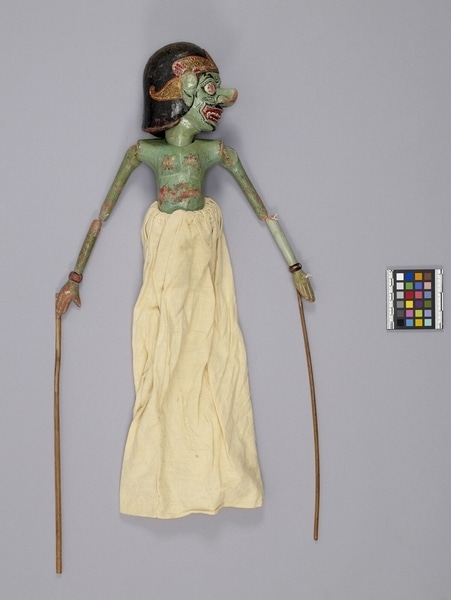Rod Puppet Item Number: Ib298 a-c from the MOA: University of British Columbia


Description
Three-dimensional male humanoid puppet: large head (part b) fits into body with skirt (part a), and a control rod (part c) with a long shaft that passes through the body and fits into the neck of the figure's head. The body has jointed arms, each with a long controlling rod attached. The figure has a green face, white eyes with red irises, and black nostrils. The figure also has a small black moustache and a thin beard, as well as a mouth that curves slightly upwards with fangs at each corner. Gold sumping and gold jamang present. Upper body painted green; breast and waist area bulging. Off-white cotton skirt. On the figure's right hand, the fingers are straight and the thumb points out. On the figure's left hand, the fingers and thumb all point down.
History Of Use
Javanese puppetry as an art form probably developed by the 11th century. The three-dimensional wooden wayang golek puppets of western Java, which are to be distinguished from the earlier and more sacred wayang kulit shadow plays puppets or other forms, appeared during the 16th century. Originally the plays depicted Javanese mythology, but after the Indian conquest of Java the Hindu epics, Ramayana and Mahabharata, were incorporated into the cycles, which comprise about 200 plays. An individual or group hires a dalang (puppet-master) to celebrate important occasions. The performances often last all night and are generally presented in three acts, with vocal and instrumental accompaniment. The individual plays vary widely in detail but usually involve conflict between good and evil. They serve a moral and religious purpose, and more recently, one of political commentary. Each puppet's character is represented by its appearance and placement onstage; protagonists with strong elements of good are placed to the right, antagonists of violent or evil nature to the left. Brajadenta is a forceful manifestation of Bima, second of the Pandawa btrothers, who are in constant conflict with the evil Kurawa brothers, their cousins and childhood companions, as detailed in the Mahabharata cycle of plays, considered the most commonly performed and popular.
Iconographic Meaning
Some characteristics are variable and symbolically incongruous side by side. Solid yellow cotton of skirt denotes a commoner but the position of the hands show nobility. Long hair a sign of youth, but puppet of large size of giant. Jamang (diadem) and sumping characteristic of nobility; green skin typically a negative or evil feature. Identified as Brajadenta, a manifestation of Bima, second of the Pandawa brothers, spiritual son of Baju, the god of wind. He is known as a crudely blunt, powerful warrior. He once entered the body of Dewa and warned Dewa of the colours red, black and yellow.
Cultural Context
Theatrical performance.
Item History
- Made in Java, Indonesia
- Owned by Tradewind Antiques before March 15, 1983
- Received from Museum of Anthropology Shop Volunteers (Funding source) and Tradewind Antiques (Seller) on March 15, 1983
What
- Name
- Rod Puppet
- Identification Number
- Ib298 a-c
- Type of Item
- puppet
- Material
- wood, cotton fibre and paint
- Manufacturing Technique
- carved, painted, woven and sewn
- Part C
- height 34.5 cm, width 2.5 cm, depth 1.0 cm
- Part B
- height 17.0 cm, width 8.5 cm, depth 13.5 cm
- Part A
- height 63.5 cm, width 16.0 cm, depth 7.5 cm
Who
- Culture
- Sundanese
- Previous Owner
- Tradewind Antiques
- Received from
- Museum of Anthropology Shop Volunteers (Funding source) and Tradewind Antiques (Seller)
Where
- Holding Institution
- MOA: University of British Columbia
- Made in
- Java, Indonesia
When
- Ownership Date
- before March 15, 1983
- Acquisition Date
- on March 15, 1983
Other
- Condition
- fair
- Accession Number
- 0886/0032 a-c